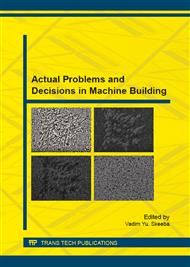p.82
p.88
p.95
p.102
p.111
p.117
p.123
p.129
p.136
An Impact of the Magnetic Field on the Fine Copper Structure under Creep Failure Conditions
Abstract:
An impact of a weak magnetic field on changes in the dislocation substructure of commercially pure copper exposed to stressing up to destruction under creep conditions was investigated. It was established that a magnetic field action on a metal exposed to creep resulted in the formation of a band dislocation substructure. In some cases grains with the dislocation chaos structure or cellular and grid substructures were revealed. In addition, quantitative differences in the dislocation substructure characteristics were also identified. A gradient nature of changes in the number of stress concentrators when moving away from the failure surface was defined. It was shown that the density of bend extinction contours characterizing the number of stress concentrators in the material decreased when moving away from the failure surface.
Info:
Periodical:
Pages:
111-116
Citation:
Online since:
August 2015
Keywords:
Price:
Сopyright:
© 2015 Trans Tech Publications Ltd. All Rights Reserved
Share:
Citation:


